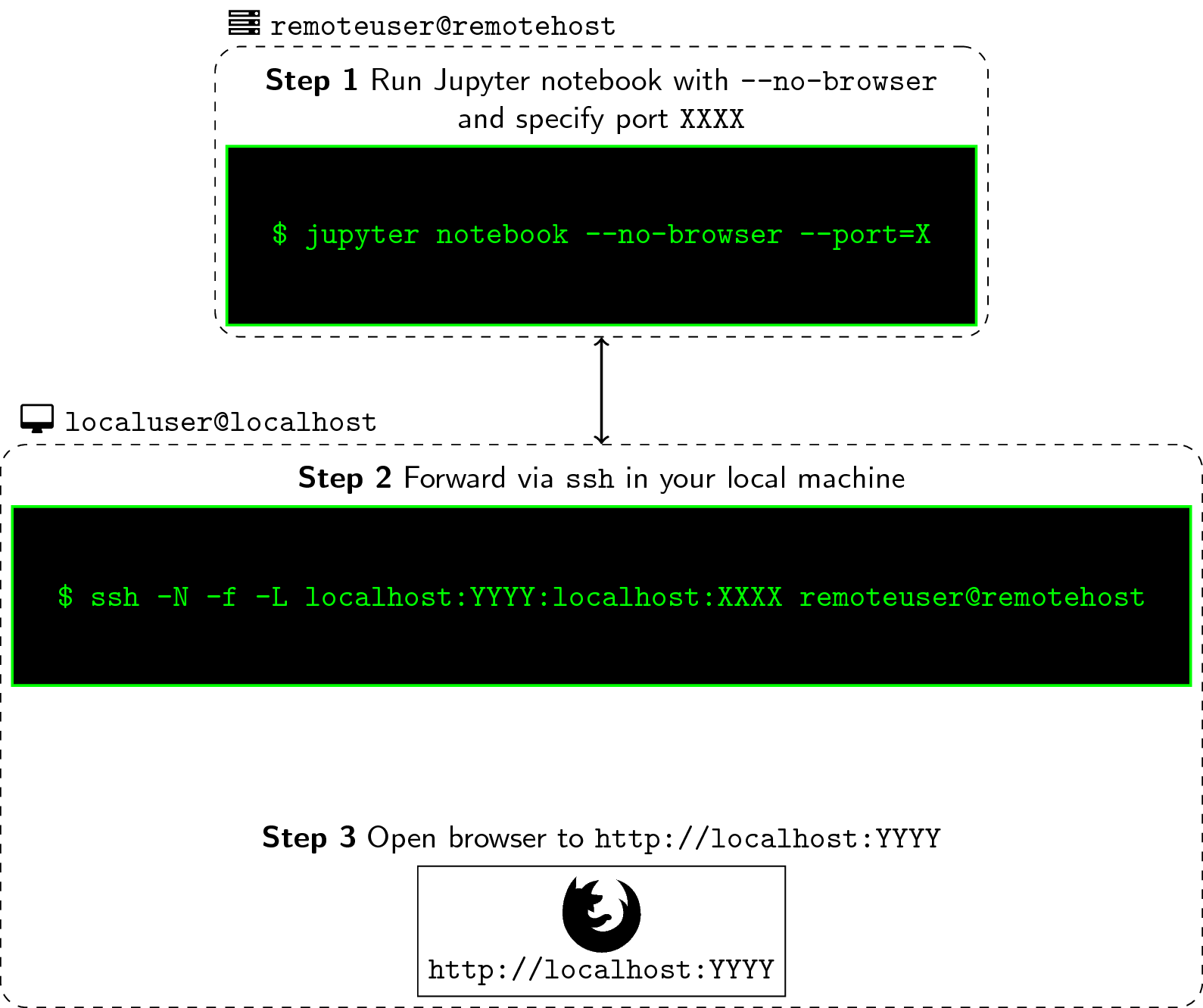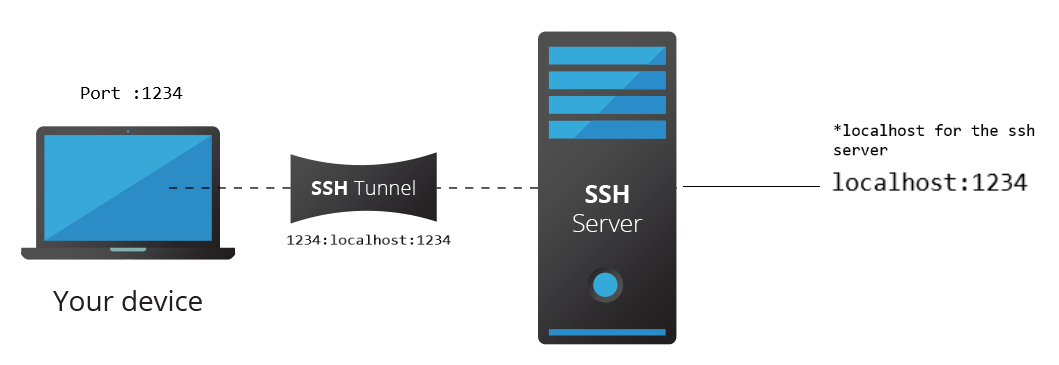Start the notebook in no-browser mode and specify a port different from any other port on the server. You will see like this.

How Can Connect Jupyter Notebook In Desired Environment In Anaconda In Server Computer By Using Putty Stack Overflow
Localhost8887 you will see your Jupyter notebooks asking for a password token.

. You can specify the access port using the --port option. Jupyter Notebook must be run from your VPS so that you can connect to it from your local machine using an SSH Tunnel and your favorite web browser. Fi cd jupyter Create a script to run jupyter echo jupyter notebook --no-browser -.
On the remote server. You will see the Jupyter Notebook running in your browser while the code in the notebook is executed on the remote server. In most cases this is simply done via an ssh command.
To function correctly the firewall on the computer running the jupyter notebook server must be configured to allow connections from client machines on the access port cNotebookAppport set in jupyter_notebook_configpy to allow connections to the web interface. Ssh into the remote-machine. RUN JUPYTER IN REMOTE SERVER outssh -T usernameserverIP.
Then copy the token and paste it and login. How to run Jupyter notebooks via pyCharm on remote. Login to Remote Server.
Its totally the same of first way So it remains typing password. Run the following on your local machine to start an SSH connection. Theres an example recipe here youll need to create as one click app a Docker server select your region and server size a cheap 2GB server will be plenty and then enter the following into the User data area.
To run Jupyter Notebook with remote kernels first you need a kernel server that exposes an API to manage and communicate with kernels. Launch a Jupyter session on the remote server. How do I create a Jupyter notebook server.
When the Jupyter extension creates the remote connection they create a temporary Notebook at the root of the Jupyter server cloudfilescode. Notebooks are great if you are covering a one-time analysis and youre in a rush to deal with data. Select the Jupyter Server.
Jupyter notebook --no-browser --port XXXX Optional. Log-in to your remote machine the usual way you do. If you are running a long task.
It allows clients to provision and communicate with. Jupyter notebook --no-browser --port8086. This placeholder Notebook is then used to relay the commands of the local Notebook however all execution context is per the placeholder notebook.
Just do it and then you can usually use jupyter notebook on the remote web browser like this. Run Notebook with Specified Port Number. Jupyter Lab and Notebook share the same configuration files so there is no need to follow different processes for each.
Run Jupyter Notebook from remote machine. You can set a new password at any time on the remote server in exactly the same way. Once connected code cells run on the remote server rather than the local computer.
Jupyter notebook After running this command you will see output similar to the following. The Jupyter Kernel Gateway satisifies the first need. Once the console shows type the following.
Jupyter notebook --no-browser --portXXXX Note. Dont forget to change jer and remote-machine to your user and machine name. Change XXXX to the port of your choice.
Local button in the global Status bar or run the Jupyter. If your remote session gets disconnected tmux will keep the session running to reconnected run tmux attach. And if you type your IP Addressport number on web browser.
This password will be used to access any Jupyter session running from this installation so pick something sensible. Once logged in to the remote server cd to the desired directory and run the following command. Forward port XXXX to YYYY and listen to it.
This headline for me was a dream come true. Step 2 Running the Jupyter Notebook. Jupyter notebook password Enter password.
Usually the default is 8888. Log-in to your remote machine the usual way you do. On the remote machine start jupyter notebook from your current directory and specify the port.
To connect to a remote Jupyter server. Running a Jupyter notebook from a remote server. Docker run -d --rm -p 808888 -e JUPYTER_TOKENletmein jupyterminimal-notebook.
To start the server simply run jupyter lab or jupyter notebook Step 5. Start the notebook in tmux or screen so that you can later close the terminal while being able to run the notebook eg. The firewall must also allow connections from 127001 localhost on ports from 49152 to 65535.
To run the Jupyter Notebook server enter the following command. Just a normal SSH login. Specify local or remote Jupyter server for connections command from the Command Palette P Windows Linux CtrlShiftP.
Replace with your username and server address. Lets run Jupyter notebook remotely with a commend below. Open Jupyter LabNotebook on your local machine.
Second you need to modify the default behavior of the Notebook server which is to spawn kernels as local processes on the same host. Ssh -NfL localhost9999localhost9999 your_user_nameremote_ip_address Go to. How to run Jupyter Notebooks on remote server SSH Using SSH Tunneling Using Reverse Proxy.
Jupyter notebook nobrowser. Optional On the remote-machine run tmux. Jupyter notebook --no-browser --port9999 On the local machine catch the forwarded port.
Steps to Run Jupyter Notebook Remotely. Steps to Run a Remote Jupyter Notebook. In your remote the notebook is now running at the port XXXX that you specified.
When youre logged into your remote via ssh you can.

Use Jupyter Notebook Remotely Pytraj 2 0 2 Dev0 Documentation

How To Install Run And Connect To Jupyter Notebook On A Remote Server Digitalocean

Running A Jupyter Notebook From A Remote Server

How To Install Run And Connect To Jupyter Notebook On A Remote Server Xpresservers

How To Install Run And Connect To Jupyter Notebook On A Remote Server Digitalocean

Tips For Running Jupyter Notebook On Remote Server Just Chillin

How To Connect To Your Remote Ipython Jupyter Notebook From Your Local Windows Machine By Chris Fotache Medium

How To Run Jupyter Notebooks On Remote Server Ssh By Pranav Gajjewar Medium
0 comments
Post a Comment